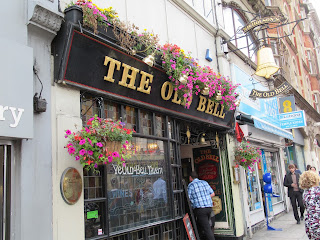First stop, The Blackfriar. An historic Art Nouveau Grade II masterpiece of a pub, originally built about 1875 on the site of a Dominican Friary in the area from about 1280-1538. The building was remodeled in 1905 by architect H. Fuller-Clark and artist Henry Poole, both committed to the free thinking of the Arts and Crafts Movement. Jolly friars appear everywhere in the pub in sculptures, mosaics and reliefs. This wonderful pub was saved from demolition by a campaign led by Sir John Betjeman (Poet Laureate of the UK from 1972-1984.) We opened the festivities with a pint of one of my favorites, Doom Bar Bitter from Sharp's Brewery in Cornwall. It's darker than an amber and tends towards caramel and biscuity notes. It's smooth and quaffable with just enough hops to keep your nose interested and a bit of a bitter bite on the back end, my idea of an ideal session beer. Since this was going to be a session by every possible measure I thought it was a logical choice with a 4.0% ABV.

Just up the street and around the corner was our second stop, The Old Bell Tavern. This pub has a long history, having been a licensed tavern for more than 300 years. Prior to the Great Fire the pub was known as the Twelve Bells, the Golden Bell, and as far back as 1500 it was known as the Sun. Rebuilt under the supervision of Sir Christopher Wren in 1670, it housed his masons who were rebuilding St Bride's Church after the London fire. Originally the pub could only be reached via an alleyway from Fleet Street and as such has a long association with printing. One of the first printing presses operated here around 1500. The stained glass front window is a distinguishing feature and quite striking. Here we opted for a pint of Rev James Original from Brains in Cardiff, Wales. This beer is full-bodied and warming with a rich palate, and an amazing finish. With a reasonable ABV of 4.5% we were able to keep things from getting out of hand too quickly.
A block or so down and on the opposite side of Fleet Street we arrive at our third destination of the day, Ye Olde Cheshire Cheese. Originally built in 1538, with cellars that probably date to a 13th century monastery housed on the site, the pub was destroyed in the Great Fire and, as the sign at the door proudly proclaims, rebuilt in 1667. Ye Olde Cheshire Cheese has operated under 15 sovereigns and seems to have as many floors! (There are really only five or six, depending upon how you count the basement levels.) Many famous people are believed to have spent time here, including the novelist Oliver Goldsmith, Mark Twain, Alfred Lord Tennyson, and Sir Arthur Conan Doyle. Charles Dickens was known to be a frequent visitor and even mentioned the pub in A Tale of Two Cities. This is a Samuel Smith's establishment, which means "useful" beers that aren't very memorable but are quite enjoyable and at economical prices. We opted for the Bitter, which supplies malty fruited notes with hints of caramel and burnt sugar. The ABV of 3.9% will keep you in good stead and allow you to drink this beer all afternoon if you like.
To get to stop #4 was a bit of a winding walk, but not too great a distance. By any measure taking time to get to Ye Olde Mitre was a good thing (sipping on a bottle of water along the way was also an excellent idea.) Quaint and cozy (or small in other parlance) this spot can be elusive, even if you have a good idea of where to look. Nestled between two buildings down a winding alley, the original pub dates to 1546 with an expansion in the 1770’s. It is said that Queen Elizabeth I danced around the cherry tree just inside the door when her father, Henry VIII, was married next door in St. Ethelredas. We like it because it’s more traditional (no televisions or electronic games) and tends to be more quiet because of this. We can report that the gents has been recently renovated and are significantly improved over a couple of years ago. We continued our run of bitters with a pint of Seafarer's from George Gale & Co. (4.5% ABV) In keeping with the tradition of English Ales, there's nothing earth-shattering in a pint of Seafarer's, but it goes down smoothly and has pleasant notes. In general two pints are much better than one, and three or four are best if you're in good company. If you're doing a pub crawl you should probably stop at one, though.
Pub #5 on our tour was The Knights Templar. Located in the former Union Bank
building, this pub takes its name from the order of Warrior Knights whose land
Chancery Lane was built across in the 12th century. It is large and spacious by any
standard and even more so for a London venue. As strange as it sounds, the restrooms are as spectacular as
the main room. Make sure to visit, even if it’s just to wash your hands. Crowds are light in mid afternoon but build as the surrounding offices shut down for the day. Abbot Ale was the selection here, a bit heady at 5.0% ABV, but this product of Greene King in Bury St. Edmunds is one of our favorites when we're in London. This ale has nicely balanced hops with a malty richness and hints of fruit that keep things interesting.
Our crawl continues just down a side street in Epic Pub Crawl Part Two at a pub added at the last minute when my partner in crime realized how close we were.




No comments:
Post a Comment